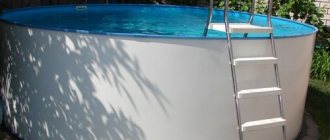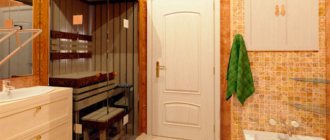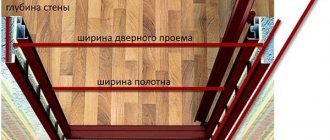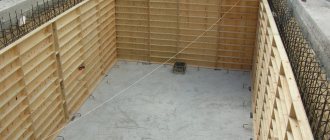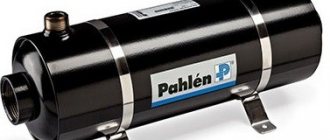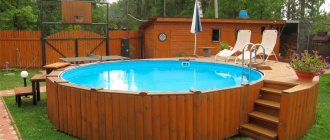Pool water heaters help maintain the water temperature at +16…+40 °C. There are several types of such devices. Some heaters require wood, electricity or gas to operate, while others operate using clean energy sources.
The choice of water heater primarily depends on the volume of water.
About heating the water in the pool
Many owners of private houses and cottages install outdoor swimming pools. Such designs can mix a large volume of water. It is possible to warm up to a comfortable temperature using natural solar heat only if the pool bowl is shallow.
If the design is designed for a large volume, the liquid will not warm up during daylight hours.
The situation is aggravated by the light-colored materials from which portable pools are made and the properties of clean water. These factors contribute to the reflection of sunlight and a decrease in the rate of heating.
In addition, some heat will be lost at night. The possibility of natural heating is excluded in cloudy weather. In this case, additional heat sources are required.
It is important for athletes that the water temperature is within +24…+26 °C. Children will be comfortable swimming at +30…+35 °C. To achieve such indicators, you can use portable heating systems that can raise the temperature to comfortable levels within 3-5 hours, and then maintain the indicators at the desired level.
Tips for using a heating system
Those who think that you just need to install a solar water heater and then use the free energy without worry are a little mistaken. The fact is that the solar collector, like any other equipment, needs periodic maintenance. First of all, this concerns cleaning glass from dust. Even slight contamination will reduce the power of the unit by 5–8%. If you do not clean the surface of the installation at all, then in a few weeks the temperature of the water leaving the device will drop by a quarter.
The second thing you will have to regularly monitor is the condition of the threaded connections in an installation made of metal-plastic pipes. The fact is that regular heating-cooling cycles contribute to loosening of fittings, and this leads to depressurization of the system and the appearance of leaks. Therefore, once every 2–3 weeks, while the centrifugal pump is operating, all manifold connections are inspected. Do not forget that the installation is assembled from plywood, lumber and steel, and all these materials and a warm, humid environment are incompatible. Therefore, timely troubleshooting will extend the life of the water heater and preserve its appearance.
At the end of the summer season, the water from the solar collector is drained, after which the installation is covered from precipitation with a thick plastic film, or even put away under a shed or in a barn.
Circles of black film floating on the surface of an outdoor pool will help the geocollector heat the water to a comfortable temperature
The last thing I would like to remind you is that it is not enough to heat the water. It is important to preserve this heat for as long as possible. If possible, a covered pavilion is built over the artificial reservoir. If finances do not allow installing a permanent shelter, then the pool is covered every evening with a special awning or plastic film. In addition to the fact that the blanket will be able to retain a few extra degrees until the morning, it will also serve as a protective barrier, preventing leaves, insects and dust from getting into the water. A good help for a solar collector are circles made of black plastic film stretched over a hula hoop. When laid on the surface of the water during the daytime, they will provide additional heating of the water and protection from debris. The only inconvenience is that you have to remove them every time before bathing.
Purpose and types of water heaters for pools
All water heaters, depending on their purpose, are divided into indoor and outdoor. However, this classification is conditional. Some gas, wood and electric systems can also be used to heat water in a backyard pool. In the summer, you can use outdoor devices to increase the temperature in indoor tanks.
Depending on the type of design, water heaters are:
- flow-through;
- heat exchange;
- heat pumps.
Another classification is based on the type of energy used to raise the temperature of the water.
Water heaters are solar.
According to it, the following types of heaters are distinguished:
- gas;
- electrical;
- solar;
- thermal;
- fuel, etc.
Heating methods
Among the main methods of heating a pool, used in most cases, are:
- Electric running water heater;
- A heat exchanger with a pump that delivers heat from the main fuel boiler used for heating or heating water in the house to a frame or permanent pool on the street;
- Heat pumping equipment for moving cold water into the water heater, and warm water back into the pool bowl;
- The most modern device for heating water is a solar collector;
- Heating water naturally is the most economical option, but loses in speed.
Electric heater
One of the most popular and relatively inexpensive devices is a flow-through electric heater, characterized by ease of installation of all components in any room and a high degree of security. The principle of operation of the device is based on the rapid heating of the water entering it using a powerful electric heater installed inside the housing and powered by a 220 W city network. The price of a heater for a pool with a volume of 50 m3 is within 24 thousand rubles.
You can select a flow-through heater for heating a pool based on the size of the reservoir. The standard power calculation scheme for maintaining heat is 1 kW per 5 m3 of water.
The main disadvantage from which the heater is not protected is the huge consumption of electricity. To heat water in a pool of standard volume you will need about 1.5 thousand kW.
Heat exchanger
If a solid fuel boiler is already installed in the house or when planning to install any stationary heat source, an excellent alternative to an electric heater would be to heat water using a heat exchanger with a circulation pump that takes heat from the source (for example, a boiler) and redirects it to heating an indoor pool.
The cost of the boiler is equal to the cost of the electric heater. The boiler runs on solid fuel and does not depend on electrical networks, and therefore can be used in houses heated with wood or coal. More modern high-power models use gas fuel.
Heat pump
A more economical option for heating pool water using electricity is to install not a separate heater, but a heat pump, the operating principle of which is similar to an air conditioner.
This type of water heater is expensive, but it pays for itself with its efficiency. When operating, the heat pump consumes 7 times less kW of energy than a standard electric heater. The water heater will pay for the difference in cost of approximately 60 thousand rubles in 2-3 seasons of maintaining heat.
solar collector
The least energy-consuming, but not too powerful way to heat water in a frame pool in a small country house, outdoors or indoors, is to install a solar collector that operates without fuel and uses the energy and heat of the sun for heating. The principle of operation of the device is very simple, and consists in delivering water to the coil, passing it through a tubular structure, where the liquid is heated, and then delivering it to the pool. The movement of water in the tubular heater is carried out by the operation of a small electric pump, which is controlled automatically, and the heat of the water in the pool is regulated manually.
Wood and fuel heating systems
This type of heater is used to increase the temperature in large swimming pools.
The fuels used are:
- wood;
- coal;
- briquettes with sawdust;
- oil;
- peat, etc.
Wood can be used as fuel.
The principle of operation of the system: the pump takes water from the pool, drives it through the filter and sends it to the storage tank of the heater. When fuel is burned, heat is released and transferred to the liquid. The already heated water is pushed further through the pipes and falls back into the pool.
This system is extremely effective. It allows you to quickly increase the temperature. Fuel heaters are easy to install and economical, but they require regular cleaning to remove combustion products.
Methods for preventing heat loss
Choosing the most powerful heating system will not be effective enough if you do not prevent heat losses resulting from:
- natural convention;
- water evaporation;
- primary heating of water;
- splashing water while swimming, etc.
To prevent most of the heat losses, a polymer coating or special blinds are quite suitable, allowing you to save 50-80% of thermal energy. At the same time, in the summer it is better to use transparent coatings that transmit ultraviolet rays, thereby promoting additional heating of the water, and in the winter months the best option is a thermal insulation blanket.
In addition to preserving heat, the covering prevents the accumulation of various types of debris in the water, a high concentration of which leads to a change of water and the cost of heating it to a minimum comfortable level.
Thus, modern equipment for heating water is presented in a fairly wide range, so it is necessary to choose it based on the features and characteristics of a particular pool, as well as financial capabilities. At the same time, you can try to heat the pool yourself, thereby saving a decent amount.
We are a professional engineering design and installation company. On our website you can receive a commercial offer and find the necessary information.
EuroHolod sells pool heating with turnkey installation. For questions related to heating, call +7(495) 745-01-41.
To receive a commercial offer
, write a request to e-mail [email protected] or send a quick request
See below
- Heating systems. Heat supply for buildings
- What is your object?
Heating by gas boiler
Gas boilers are used to heat large swimming pools. The principle of operation of such water heaters is similar to fuel ones, however, it is not wood or coal that burns, but natural gas or propane. In such devices, water from the pool is pumped into the boiler storage tank. The burning gas releases heat to the liquid. The heated water returns to the pool. Fluid circulation occurs.
Heating with a gas boiler is needed for large swimming pools.
The advantage of this device: even if there is a lot of water in the pool, it will heat up quickly. The disadvantages of gas boilers include the need to obtain permission to install equipment. Installation should only be carried out by a specialist.
Heating using a heat exchanger
If a winter pool is installed or with a large tank, then heating is installed based on a heat exchanger. It connects directly to the heating system of the house, powered, for example, by a gas boiler. Made in the form of a coil in a flask through which hot water flows.
The coolant moves due to the circulation pump. The liquid enters the flask, where it is heated by the coil. With each new circle it heats up more and more. Then it returns to the bowl. The process is automatic and does not require special control. The user only sets the temperature on the thermostat.
The heater is selected based on the dimensions of the pool. On the first day, turn it on at maximum power, then maintain the optimal temperature. In this case, sudden changes should not be allowed.
- heats large volumes with less energy consumption;
- ease of use.
The technique is used for frame and inflatable models. In winter, organize additional insulation of the structure. Otherwise, most of the heat will escape into the atmosphere.
Heating a pool with a heat pump
Heat pump heaters are a complex design in which water drawn from the pool passes through a filter system and then enters a pump. Inside it, it moves along a coil.
Air pumped from outside collides with the refrigerant, which leads to the formation of a large amount of condensate. This substance, under the influence of temperature differences, quickly turns into steam, and then is pumped into a compressor, where it is compressed to 20-25 atm. This process is accompanied by the release of heat. Such systems are compact.
Operation and Maintenance
When using heated floors, a number of rules must be observed:
- the temperature in the room should be within the range of +26 - +30;
- water temperature 23 - 27 degrees;
- You need to turn on the heating in advance, since heating of water with heated floors is carried out slowly.
By installing automatic thermostats, the process of maintaining the desired temperature will be easier. The room thermostat operates when the temperature changes by 1 degree, but the heater’s response to this is not fast. The use of a chromo-thermostat will increase the efficiency of the system.
Heat exchanger for swimming pool
The heat exchange heater has a cylindrical reservoir and a coil, the inlet and outlet of which are connected to the heating system. Water is taken from the pool and pumped into the tank. Here it is heated and released back into the pool under pressure. To regulate the heating process, such devices are equipped with a thermostat.
The pool heat exchanger has a cylindrical tank.
Advantages and disadvantages
The advantage of heat exchangers is low energy consumption, because Connection to the electrical network requires only a pump, which pumps water into the tank and pushes it back into the pool.
In addition, the positive aspects of the device include:
- high reliability;
- efficiency;
- unpretentiousness to operating conditions;
- long working life.
The main disadvantage of the system is the slow heating of a large volume of water.
Operation of the heat exchanger is possible only in the autumn-winter period, i.e. during the heating season.
Criteria for selecting water heating devices
When choosing a device for heating water in a tank, you need to pay attention to the following factors:
- Pool type. If we compare 2 pools of the same volume, then an open-type pool will require equipment of greater power than an indoor one, since the process of cooling the water in the fresh air occurs much faster.
- Pool volume. For a small-volume tank, a low-power device with an average heating rate is quite sufficient, and for a large-volume one, exactly the opposite is true.
- Warm-up speed. More powerful devices have a high heating rate, but their cost is also an order of magnitude higher than any low-power devices.
- Operational period. When using a pool in the winter season, equipment with a high degree of heat transfer is suitable. At the same time, in the summer, especially hot and dry weather, a medium-power device is quite suitable.
Thus, the advisability of purchasing a specific water heating device depends on the specific type of pool and the technical characteristics of the equipment itself.
Electric pool heaters
Now the production of electric heaters of different power has been launched. They are equipped with a thermostat. Inside the plastic case there is a reservoir with an electric heating element. The liquid is pumped into the electric heater by a special pump. Upon contact with the heating element, the water temperature quickly rises. After this, the liquid is returned back to the pool. Such systems are often equipped with an automatic locking device, which is triggered when the water circulation process is disrupted and there is a risk of overheating and breakdown of the device.
Electric pool heaters are equipped with a thermostat.
Advantages and disadvantages
The advantages of electric water heaters include:
- Compactness. They are small in size, so they can be quickly moved if necessary.
- Easy to install. Installation of equipment does not require specific skills.
- Water purification. Almost all models are equipped with filters.
- Autonomy. The water heater maintains the temperature and does not require additional adjustment.
- Reliability. In such devices, the heating elements have a protective coating that protects them from oxidation.
Electric heaters also have some disadvantages. Often their power is not enough to significantly increase the temperature in large pools. Electrical components are well insulated, but it is better to take precautions and avoid contact with water to prevent electric shock. In addition, they have high energy consumption.
What type of heated floors to choose
There are two types of heated floors - water and electric (cable and infrared). They differ in the source of heating. For structures with pipes, this is a hot coolant. For electric ones - the power grid.
Water heating is recommended for the pool, as there is high humidity in the room, which is why electric heating is considered more dangerous. But if you install it in a screed that will protect the heating cable from moisture, then you can lay the cable floor. Film systems can be installed to heat paths, but they require high-quality waterproofing.
Popular manufacturers of electric heaters
Some companies specializing in the production of swimming pools and equipment for them have already received a large number of positive reviews. When choosing a heater, it is recommended to pay attention to the products of the companies listed below.
Pahlen
Pahlen is a Swiss company that produces heaters with a power of up to 18 kW. The devices are capable of heating the temperature in the pool up to +40 °C and are characterized by a high degree of safety and reliability. The devices are equipped with overheating protection, which is triggered when the temperature rises to +60 °C. The most powerful devices in the line of this company require increased network voltage - 380 V.
Pahlen produces heaters with power up to 18 kW.
Bestway
Bestway is a joint American-Chinese production company specializing in the production of low-power heaters suitable for maintaining water temperature in small swimming pools. Energy consumption is only 3 kW.
The heaters are low-power, but with proper operation they can increase the water temperature in a small pool to +35 °C. Most models have a protected heating element installed that can increase the heating rate.
Budget devices do not have a thermostat, so you need to independently control the water temperature.
Intex
Intex is an American company that produces a large number of electric, solar, heat exchange and fuel heaters. The devices vary in power. Both high-quality stainless steel and durable plastic are used as the material for the internal tank and body.
Intex produces a large number of solar heaters.
The heaters of this company have a high degree of safety. They are often equipped with fuses against overheating and short circuits. In addition, most models have a thermostat, making it easier to control the temperature.
Electro
Elecro is an English company that produces electric heaters and heat exchangers for all types of swimming pools. The power of the devices ranges from 3 to 18 kW. Elecro heaters are made from durable materials and therefore have a long service life. The devices are economical. Most models can be mounted in both horizontal and vertical planes.
Difficulty of choice
Before purchasing any type of pool water heater, you need to determine the following necessary characteristics:
- Power - it will depend on the volume of the hydraulic facility, i.e. from the water mass that will need to be heated. The power of the device is completely reflected in the speed of heating the water. Thus, for large volumes a powerful device will be required, and often an electric heater is not an option for this;
- Heating method - if you plan to heat water in a private or country house, then a flow-through model will be the best choice. Its advantage will be its small size, so it can be mounted even in a small area. Most flow systems operate in cycles;
- Type of energy source - here a big role is played by which source is more accessible for a certain region. Also, it is worth calculating the possible costs of paying for energy from this source. Naturally, the cheapest source is solar energy, but it is not available in all regions, and the cost of the device is quite high. Heat exchangers are, of course, more common in this regard.
Solar collectors
In regions where there is rarely cloudy weather in summer, it is advisable to install solar collectors. There are several options for such systems. Some of them contain special batteries, while others have a more primitive structure and work due to the natural heating of the surface during the daytime. If the number of panels is correctly calculated, 3-5 hours is enough to warm the water in the pool to +30 °C.
Solar collectors are installed in places where there is a lot of light.
How does heating occur?
The solar system has a fairly simple structure. The main component is the collector - a structure of small diameter pipes attached to the base. This element is always painted dark. The pipes heat up quickly, and then the heat is transferred to the water moving through them.
The system is equipped with an electric pump. This device is needed to draw water from the pool. Often collectors are equipped with a thermostat. Once cold water enters the system, its supply stops. The liquid in the pipes is heated, after which it is discharged into the pool. Often, to increase the efficiency of the collector, electrical heating elements are installed inside it.
Types of manifolds for heating swimming pools
All types of collectors are divided into low, medium and high temperature.
Depending on the type of construction they are:
- flat;
- vacuum.
Collectors are either flat or vacuum.
In flat-plate collectors, the plate that absorbs solar energy is made of copper or aluminum. These materials are characterized by high thermal conductivity. To enhance the effect, they are coated with a special coating that collects thermal energy.
An aluminum tube system is attached to the surface of the absorption layer. The plate is covered with solar glass on top - it does not contain iron impurities, so it does not reflect the sun's rays. In addition, the material is highly resistant to mechanical damage.
The collector frame is made of stainless steel or aluminum. The base is insulated with mineral wool. There are inlet and outlet connections on both sides of the device. The advantage of flat collectors is the ability to mount them on any surface, incl. house facade, roof, special stand, etc. The main thing is that the surface is directed towards the south.
Vacuum solar collectors are a system consisting of individual tubes fixed to the top panel. Based on the principle of operation, this heater is similar to a thermos. Inside the flask, made of high-strength geoglass, there is a copper tube. Between these elements there is a vacuum, which is good thermal insulation.
There are models with direct circulation: cold water is introduced into one hole, and hot water is discharged from the other. In this case, the coolant moves along a closed circuit. Such collectors can be mounted both vertically and horizontally. In other models, the tubes are attached using threads.
Water heating systems
In summer, pyramidal and flexible solar heat collectors can be used. The first option is suitable when there is little space near the pool. The second requires a large enough area to place the mats.
Pyramid collectors can be used.
Pyramid collectors are suitable for heating small swimming pools. This system is a hemisphere, on the surface of which a hose with a diameter of 25 to 40 mm is attached in a circular manner. The sphere quickly heats up, increasing the temperature of the water circulating in it, taken from the pool.
Flexible manifolds are more efficient. This is a set of mats that connect to each other. If necessary, you can add the required number of elements to ensure more intense heating of the water. Mats made of black dense polyethylene contain a coil inside. This design ensures good heating of the water. The more mats are connected to each other, the better the system works. A pump equipped with a filter is used to circulate water.
Optimal choice of material for the heater
To choose the right material for your pool heater, you need to consider the following factors:
Possibility of transportation. Due to its heavy weight, it is better to place a device made of bricks permanently, on a good foundation.
If the pool is dismountable and installed in different places, then it is better to use a metal structure.
Availability of free space. Metal boilers take up less space than brick ones; the brick structure will need to be protected from the effects of precipitation: build a roof or assemble a stove in the building.
Cost and availability of materials. Possibility to hire a qualified welder or stove mason.
A brick cauldron is durable and looks good. A brick oven can also perform a number of other functions: heat a room, cook food. If you have the skills, you can make such a device yourself, which will significantly reduce the cost of the entire heating system.
A homemade metal structure is chosen if the budget is limited.
How to make a solar collector for a swimming pool with your own hands
With your own hands and from scrap materials, you can make a simplified version of a flat-plate solar collector. But the design is suitable for use only in summer; in winter it is ineffective. It is extremely important to assemble and connect the device correctly.
Necessary materials
To make the collector you will need:
- plastic pipes;
- wooden beam with a section of 5x5 cm;
- thin slats;
- plywood;
- black paint;
- metal corner;
- metal sheets;
- self-tapping screws;
- small water pump;
- geoglass;
- tees;
- mineral wool.
- Exhaust valve;
- drain tap.
To make the collector you will need plastic pipes.
To create a cushion under the system you will need sand, gravel and geotextiles. You need to purchase consumables for the welding machine in advance.
Build process
The manifold assembly process includes the following steps:
- Make a frame from wooden slats and cover it with plywood.
- Place insulation on the bottom and make a sheathing of thin slats.
- Attach thin metal plates to the surface.
- Paint the entire structure black.
- Cut the pipes and connect them together with fittings and angles to form a coil.
- Mount pipe fasteners on the surface of the shield.
- Fix the coil on the frame and paint it black
- Carry out a hydraulic test.
- Equip the inlets and outlets of the coil using tees and shut-off valves.
- Cover the top of the structure with geoglass.
From steel corners you need to weld a platform on which the entire system will be mounted.
Installation and connection of the solar collector
First of all, you need to choose a good site for installing a solar collector. Homemade structures are often less efficient than professional ones, so it is better to place them in close proximity to the pool - this will reduce heat loss during water circulation.
Connecting a solar collector reduces heat loss.
The selected place should be prepared: remove the top soil layer and form a sand and gravel cushion. Then the surface is carefully leveled and a layer of concrete is poured. If desired, the platform can be made from paving slabs.
After this, a metal frame is installed.
The next step is to install the collector on the platform. It is important that it faces south. Then a medium-power pump is connected - it will ensure a slow flow of water through the system and better heating.
At the final stage, the efficiency of the collector is checked.
Preparing for work
Making your own water heater for a swimming pool means you can save a lot on the purchase of expensive equipment. Using solar energy for heating is the best option to save both your money and thermal energy.
Material selection and tips
You will need quite a lot of materials to create a solar heater, but you should not skimp on them - all your costs will pay off in the first few weeks of operation. The most common wood can be used, for example, pine. Before using it, it is recommended to treat the surface with a special antiseptic to prevent rotting or the formation of pests. It is recommended that you initially buy the highest quality, albeit expensive, fasteners and adapters for assembling the manifold.
Tools
- Beam with a square section of 50 mm - 38 m.
- Plywood 12–15 mm thick - 5 m².
- Metal-plastic pipe with a diameter of 0.5 inches - 110 m.
- Plastic fasteners for pipes - 160 pcs.
- Carbon adapter for metal-plastic pipes of the male-female type - 60 pcs.
- Carbon adapter for metal-plastic pipes of the “female-female” type - 62 pcs.
- Adapter for fitting with a diameter of 0.5 inches - 105 pcs.
- Air outlet valve - 1 pc.
- Check valve - 1 pc.
- Tee with a diameter of 0.5 inches - 3 pcs.
- Drain tap with a diameter of 0.5 inches - 2 pcs.
- Submersible pump 3–4 m³/h – 1 pc.
- Corrugated hose - 2 pcs.
- Sheet metal - 5 m².
- Aluminum profile 12 cm high - 4 pcs.
- Steel corner (galvanized) 50x100 mm – 4 pcs.
- Glass 4 mm thick - 4 pcs.
- Black nitro paint - 5 l.
- Board 30x100 mm - 9 m.
- Ruberoid (or other rolled waterproofing) – 5 m².
- Paving slabs from 40 mm thick - 4 m².
- Self-tapping screws for wood.
- Plumbing fum tape.
- River sifted sand.
- Silicone sealant.
The simplest solar water heater - DIY instructions
From scrap materials you can make simple solar water heaters that are highly efficient in the summer. Cellular polycarbonate and plastic bottles will serve as a good basis for creating such devices.
Made from cellular polycarbonate
First, a frame is made from a wooden beam. Then a coil is welded from copper tubes in which water will circulate. At its ends, fittings are installed to connect the supply and discharge pipes.
The water heater can be made of cellular polycarbonate.
Plywood is attached to one side of the frame, and insulation is placed on top of it. After this, the coil is fixed to the frame. The top of the structure is covered with a polycarbonate sheet. The finished collector is connected to the pump. In addition, a pipe is installed that drains the liquid back into the pool. You can then turn on and test the system.
From plastic bottles
For the manufacture of the device, containers with a volume of 1.5 liters are better suited. A hole should be drilled in the bottom of each of them, the diameter of which should coincide with the neck. Then one bottle is inserted into the other, secured together with a drilled cap. The connections should be soldered so that they are airtight. In this way, 5-6 containers are fastened in a row.
You need to make at least 5 of these batteries. They are connected to each other with a hose to form a coil. The bottles are painted black. Then the formed coil is placed in a pre-made housing, in which the inlet and outlet holes are made. The top of the heater is covered with transparent polycarbonate or glass.
Instead of an epilogue
An analysis of the Russian market for the devices in question has established that the vast majority of models on it are represented only by foreign manufacturers. First of all, this is due to the underdevelopment of this industry in Russia. At the same time, the budget segment is represented exclusively by solar models, which are not suitable for heating large volumes. The most widespread are only solid fuel samples, the use of which is more focused on suburban households.
DIY solar storage system
Solar storage systems are often used to install a summer shower in the country. A container of water is placed on top of the cabin. The liquid is heated throughout the day and then used for bathing. However, if desired, you can make a larger storage system suitable for heating the water in the pool. To do this, it is better to use several plastic tanks. They are connected to each other by a metal-plastic pipe. The fixation points are carefully sealed.
On one side of the system, an inlet hose is connected, through which the pump will pump water from the pool into the storage tanks. On the opposite side there is an outlet through which the liquid is drained back. In addition, it is necessary to install shut-off valves so that after the pump stops working, the water does not continue to circulate. Remaining in the drive, it will quickly heat up to the desired temperature. After this, it can be launched back into the pool.
Budget options
Let's look at the options that can be used, as they say, at worst. These are far from the most practical methods, but they are very cheap and accessible to everyone.
Boiler or kettle
Kettle for heating water
If you have a very small pool for children, then you can heat the water to the desired temperature in a simple, proven way. Just heat up the water in several pots and a kettle. The solution to the problem is not surprising, and it has its advantages.
Pros:
- For free;
- Available.
Minuses:
- Only for miniscule volumes;
- A frustrating process.
Snail
The snail is a mini solar collector. They have a similar operating principle. The water is taken into the pipes, heated by the sun and returned to the pool. Its design is so simple that homemade snails are not such a rare occurrence.
Snail for heating
Since this is a brother of the solar collector, the pros and cons are similar. But the snail is smaller in size, so it wins in price, but loses in efficiency.
Pros of using snail:
- Very affordable price;
- Does not require installation;
- Easy to use.
Disadvantages of using a snail:
Effective only in sunny weather.
Thermal heating blanket
A thermal blanket can also help you heat up the water in your pool. It is also called “Special Pool Covering”. You simply stretch a special fabric over the pool, and now the heat from the sun is not reflected from the water, but is retained by the coating. Thus, in a few hours the water can warm up by 3-4 degrees.
Thermal heating blanket
It should be noted that in the case of a special coating, only the top layer of water is heated. To ensure that the water heats evenly, turn on the pump, which will mix the upper and lower layers.
Usually they buy a thermal blanket for a swimming pool of a special shape for a specific model. If you have a custom-made pool, then you can cut out the film yourself or order it.
Pros of using a thermal blanket:
- Affordable price of the canvas itself;
- Free operation;
- Protects against insects, leaves and other dirt.
Disadvantages of using a thermal blanket:
Rarely is it the only way to heat water.
Pool heating with wood
If you are relaxing in the country, then getting dry firewood should not be a problem for you. Therefore, this method is more relevant in dachas than anywhere else. Therefore, you should take a closer look at such devices.
Wood heaters
The operating principle is similar to that of a heat pump. The device takes a portion of water into its pipes. In them, it is heated by fire, and having reached the desired temperature, it returns to the pool. The cycle is then repeated again and again until the water in the pool reaches a comfortable level.
Advantages of heating a pool with wood:
- Affordable device price
- Economical operation
- Available if you have firewood
Disadvantages of heating a pool with wood:
Not available if there is no firewood
Now you know how you can heat a swimming pool at your dacha. As you can see, there are really a lot of options. And all that remains is to choose the method that suits you.
Simple options
Not everyone can afford an expensive water heater. For example, if the pool is installed for a short time. To do this, you can make a pool water heater with your own hands.
Boiler or kettle
To make it enjoyable for children to swim in an inflatable pool, you can use available means. The method is very simple - just heat water in a kettle or saucepan and add it to the pond.
